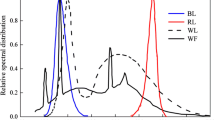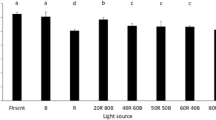Abstract
The effects of fluorescent light and different light-emitting diodes (LEDs) with white, red, green, and blue light on two macroalgal species, Gracilaria lemaneiformis (Rhodophyta) and Ulva lactuca (Chlorophyta), have been investigated via the measurements of growth rates, photosynthesis, and biochemical contents of pigments (i.e., chlorophyll a, carotenoids, and phycobilin) and soluble protein. In the two species, white LEDs showed similar effects to fluorescent lamps on the relative growth rates (RGRs) and gross maximum photosynthetic rate (Pmax). In addition, green LEDs contributed to the highest RGRs and Pmax in G. lemaneiformis. Interestingly, when compared with fluorescent lamps, green LEDs resulted in a significantly higher Pmax in U. lactuca. Furthermore, blue LEDs contributed to the highest RGRs of U. lactuca, while the red LEDs led to the lowest RGRs of U. lactuca. Overall, our study suggests that LEDs are alternative monochromatic light sources to fluorescent lamps in G. lemaneiformis and U. lactuca cultivation.




Similar content being viewed by others
References
Aguilera J, Gordillo FJL, Karsten U, Figueroa FL, Niell FX (2000) Light quality effect on photosynthesis and efficiency of carbon assimilation in the red alga Porphyra leucosticta. J Plant Physiol 157:86–92
Beer S, Eshel A (1985) Determining phycoerythrin and phycocyanin concentrations in aqueous crude extracts of red algae. Aust J Mar Freshw Res 36:785–792
Berner T, Dubinsky Z, Wyman K, Falkowski P (1989) Photoadaptation and the “package” effect in Dunaliella tertiolecla (Chlorophyceae). J Phycol 25:70–78
Bradford MM (1976) A rapid and sensitive method for the quantitation of microgram quantities of protein utilizing the principle of protein-dye binding. Anal Biochem 72:248–254
Brown CS, Schuerger AC, Sager JC (1995) Growth and photomorphogenesis of pepper plants under red light-emitting diodes with supplemental blue or far-red lighting. J Am Soc Hortic Sci 120:808813
Chen CY, Yeh KL, Aisyah R, Lee DJ, Chang JS (2011) Cultivation, photobioreactor design and harvesting of microalgae for biodiesel production: a critical review. Bioresour Technol 102:71–81
Crawford MH (2009) LEDs for solid-state lighting: performance challenges and recent advances. IEEE J Sel Top Quantum Electron 15:1028–1040
Darko E, Heydarizadeh P, Schoefs B, Sabzalian MR (2014) Photosynthesis under artificial light: the shift in primary and secondary metabolism. Phil Trans R Soc B 369:20130243
Dayani S, Heydarizadeh P, Sabzalian M (2016) Efficiency of light-emitting diodes for future photosynthesis. In: Pessarakli M (ed) Handbook of photosynthesis, 3rd edn. CRC Press, Boca Raton pp, pp 761–783
Dring MJ (1981) Chromatic adaptation of photosynthesis in benthic marine algae: an examination of its ecological significance using a theoretical model. Limnol Oceanogr 26:271–284
Dutta Gupta S, Jatothu B (2013) Fundamentals and applications of light-emitting diodes (LEDs) in in vitro plant growth and morphogenesis. Plant Biotechnol Rep 7:211–220
Figueroa FL, Aguilera J, Jiménez C, Vergara JJ, Robles MD, Niell FX (1995a) Growth, pigment synthesis and nitrogen assimilation in the red alga Porphyra sp. (Bangiales, Rodophyta) under blue and red light. Sci Mar 59:9–20
Figueroa FL, Aguilera J, Niell FX (1995b) Red and blue light regulation of growth and photosynthetic metabolism in Porphyra umbilicalis (Bangiales, Rhodophyta). Eur J Phycol 30:11–18
Ghimire BK, Lee JG, Yoo JH, Kim JK, Yu CY (2017) The influence of light-emitting diodes (LEDs) on the growth, antioxidant activities, and metabolites in adventitious root of Panax ginseng C.A. Meyer. In: Dutta Gupta S (ed) Light emitting diodes for agriculture: smart lighting. Springer, Singapore, pp 259–272
Hanus-Fajerska E, Wojciechowska R (2017) Impact of light-emitting diodes (LEDs) on propagation of orchids in tissue culture. In: Dutta Gupta S (ed) Light emitting diodes for agriculture: smart lighting. Springer, Singapore, pp 305–320
Haxo FT, Blinks LR (1950) Photosynthetic action spectra of marine algae. J Gen Physiol 33:389–422
Henley W (1993) On the measurement and interpretation of photosynthetic light-response curves in algae in the context of photoinhibition and diel changes. J Phycol 29:729–739
Kang L-K, Huang Y-J, Lim W-T, Hsu P-H, Hwang P-A (2020) Growth, pigment content, antioxidant activity, and phytoene desaturase gene expression in Caulerpa lentillifera grown under different combinations of blue and red light-emitting diodes. J Appl Phycol. https://doi.org/10.1007/s10811-020-02082-8
Katsuda T, Lababpour A, Shimahara K, Katoh S (2004) Astaxanthin production by Haematococcus pluvialis under illumination with LEDs. Enzym Microb Technol 35:81–86
Khan N, Abas N (2011) Comparative study of energy saving light sources. Renew Sust Energ Rev 15:296–309
Kim JK, Mao Y, Kraemer G, Yarish C (2015) Growth and pigment content of Gracilaria tikvahiae McLachlan under fluorescent and LED lighting. Aquaculture 436:52–57
Korbee N, Figueroa FL, Aguilera J (2005) Effect of light quality on the accumulation of photosynthetic pigments, proteins and mycosporine-like amino acids in the red alga Porphyra leucosticta (Bangiales, Rhodophyta). J Photochem Photobiol B 80:71–78
Kurilčik A, Miklušytė-Čanova R, Dapkūnienė S, Žilinskaitė S, Kurilčik G, Tamulaitis G, Duchovskis P, Žukauskas A (2008) In vitro culture of Chrysanthemum plantlets using light-emitting diodes. Cent Eur J Biol 3:161–167
Lahaye M, Jegou D (1993) Chemical and physical-chemical characteristics of dietary fibres from Ulva lactuca (L.) Thuret and Enteromorpha compressa (L.) Grev. J Appl Phycol 5:195–200
Le B, Shin J-A, Kang M-G, Sun S, Yang SH, Chung G (2018) Enhanced growth rate and ulvan yield of Ulva pertusa using light-emitting diodes (LEDs). Aquac Int 26:937–946
Li H, Yu X, Jin Y, Zhang W, Liu Y (2008) Development of an eco-friendly agar extraction technique from the red seaweed Gracilaria lemaneiformis. Bioresour Technol 99:3301–3305
López-Figueroa F, Rüdiger W (1991) Stimulation of nitrate net uptake and reduction by red and blue light and reversion by far-red light in the green alga Ulva rigida. J Phycol 27:389–394
Ma R, Thomas-Hall SR, Chua ET, Eltanahy E, Netzel ME, Netzel G, Lu Y, Schenk PM (2018) LED power efficiency of biomass, fatty acid, and carotenoid production in Nannochloropsis microalgae. Bioresour Technol 252:118–126
Marchetti J, Bougaran G, Jauffrais T, Lefebvre S, Rouxel C, Saint-Jean B, Lukomska E, Robert R, Cadoret JP (2013) Effects of blue light on the biochemical composition and photosynthetic activity of Isochrysis sp. (T-iso). J Appl Phycol 25:109–119
Miki O, Okumura C, Marzuki M, Tujimura Y, Fujii T, Kosugi C, Kato T (2017) Contrasting effects of blue and red LED irradiations on the growth of Sargassum horneri during the germling and immature stages. J Appl Phycol 29:1461–1469
Muthuvelan B, Fujimori K, Murugan C, Kulandaivelu G (1997) Influence of irradiation quality on photosynthetic pigments, saccharides, nitrate reductase activity, thylakoid organization and growth of Ulva pertusa. Biol Plant 40:211–218
Poudel PR, Kataoka I, Mochioka R (2008) Effect of red- and blue-light-emitting diodes on growth and morphogenesis of grapes. Plant Cell Tissue Organ Cult 92:147–153
Qi Z, Liu H, Li B, Mao Y, Jiang Z, Zhang J, Fang J (2010) Suitability of two seaweeds, Gracilaria lemaneiformis and Sargassum pallidum, as feed for the abalone Haliotis discus hannai Ino. Aquaculture 300:189–193
Son K-H, Jeon Y-M, Oh M-M (2016) Application of supplementary white and pulsed light-emitting diodes to lettuce grown in a plant factory with artificial lighting. Hortic Environ Biotechnol 57:560–572
Teo CL, Atta M, Bukhari A, Taisir M, Yusuf AM, Idris A (2014) Enhancing growth and lipid production of marine microalgae for biodiesel production via the use of different LED wavelengths. Bioresour Technol 162:38–44
Terashima I, Fujita T, Inoue T, Chow WS, Oguchi R (2009) Green light drives leaf photosynthesis more efficiently than red light in strong white light: revisiting the enigmatic question of why leaves are green. Plant Cell Physiol 50:684–697
Tsekos I, Niell FX, Aguilera J, López-Figueroa F, Delivopoulos SG (2002) Ultrastructure of the vegetative gametophytic cells of Porphyra leucosticta (Rhodophyta) grown in red, blue and green light. Phycol Res 50:251–264
Wahbeh MI (1997) Amino acid and fatty acid profiles of four species of macroalgae from Aqaba and their suitability for use in fish diets. Aquaculture 159:101–109
Wellburn AR (1994) The spectral determination of chlorophylls a and b, as well as total carotenoids, using various solvents with spectrophotometers of different resolution. J Plant Physiol 144:307–313
Xu S, Zhang L, Wu Q, Liu X, Wang S, You C, Li Y (2011) Evaluation of dried seaweed Gracilaria lemaneiformis as an ingredient in diets for teleost fish Siganus canaliculatus. Aquac Int 19:1007–1018
Yang Y, Chai Z, Wang Q, Chen W, He Z, Jiang S (2015) Cultivation of seaweed Gracilaria in Chinese coastal waters and its contribution to environmental improvements. Algal Res 9:236–244
Yeh N, Chung J-P (2009) High-brightness LEDs—energy efficient lighting sources and their potential in indoor plant cultivation. Renew Sust Energ Rev 13:2175–2180
Zou D, Gao K (2013) Thermal acclimation of respiration and photosynthesis in the marine macroalga Gracilaria lemaneiformis (Gracilariales, Rhodophyta). J Phycol 49:61–68
Funding
This study was supported by the Natural Science Foundation of Guangdong Province (No. 2018B030311029 and 2019B121202001), Science and Technology Planning Project of Guangzhou (Nos. 201904010287).
Author information
Authors and Affiliations
Corresponding author
Additional information
Publisher’s note
Springer Nature remains neutral with regard to jurisdictional claims in published maps and institutional affiliations.
Rights and permissions
About this article
Cite this article
Gong, J., Liu, Z. & Zou, D. Growth and photosynthetic characteristics of Gracilaria lemaneiformis (Rhodophyta) and Ulva lactuca (Chlorophyta) cultured under fluorescent light and different LED light. J Appl Phycol 32, 3265–3272 (2020). https://doi.org/10.1007/s10811-020-02151-y
Received:
Revised:
Accepted:
Published:
Issue Date:
DOI: https://doi.org/10.1007/s10811-020-02151-y




